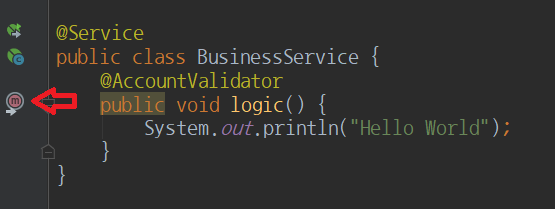먼저, AOP가 뭔지에 대해 알아보자.
Aspect-Oriented Programming 이란 프로그램 구조에 대해 또 다른 사고방식을 제공함으로써 Object-Oriented Programming을 보완한다. OOP 모듈성의 핵심 단위는 클래스인 반면, AOP는 모듈화 단위가 관점(Aspect)이다. @Transactional이 대표적인 예이다. 공통의 기능(트랜잭션)을 분리 및 모듈화하여 여러 코드(insertUser, selectMoney)에 쉽게 적용할 수 있게 해준다.
특정 계정의 ID와 token을 통해 유효한지 확인하는 코드가 프로젝트 전반에 산재해 있다고 가정을 해보자. 그리고 이를 비즈니스 코드와는 크게 관계없는 하나의 공통된 관점으로 판단을 하고, AOP를 적용시켜보자. 자세한 코드는 github를 참고하자.
(제목에 대한 답만 알고 싶으면 '3. AOP에서 메소드의 파라미터 이름을 알아와서 매핑 시킬 순 없을까?'만 보면 된다.)
1. 일단 동작하는 AOP 만들기
@Retention(RetentionPolicy.RUNTIME)
@Target(ElementType.METHOD)
public @interface AccountValidator {
}@Aspect
@Component
public class ValidatorAspect {
@Pointcut("@annotation(com.ms.blogaopparametername.aop.AccountValidator)")
public void accountValidator() {}
@Before("accountValidator()")
public void validateAccount() {
System.out.println("AOP");
}
}@SpringBootApplication
public class BlogAopParameterNameApplication {
private final BusinessService businessService;
public BlogAopParameterNameApplication(BusinessService businessService) {
this.businessService = businessService;
}
public static void main(String[] args) {
SpringApplication.run(BlogAopParameterNameApplication.class, args);
}
@Bean
public CommandLineRunner commandLineRunner() {
return (run) -> this.businessService.logic();
}
}@Service
public class BusinessService {
@AccountValidator
public void logic() {
System.out.println("Hello World");
}
}@AccountValidator를 작성한 메소드에 AOP를 걸었고, 순차적으로 'AOP', 'Hello World'가 출력되게 된다.
IDE를 통해서도 AOP가 제대로 걸려있음을 확인할 수 있다.
2. 계정의 유효성을 판단하려면 ID와 Token 값을 알아야 한다. logic()에 파라미터로 추가해 보자.
@Service
public class BusinessService {
@AccountValidator
public void logic(Long id, String token) {
System.out.println("Hello World");
}
}유효성을 AOP를 통해 판단하려면, Aspect에서 id와 token 값을 가져와야한다. 간단하게 Pointcut의 표현식 중 하나인 args를 사용해보자.
@Aspect
@Component
public class ValidatorAspect {
@Pointcut("@annotation(com.ms.blogaopparametername.aop.AccountValidator)")
public void accountValidator() {}
@Before("accountValidator() && args(id,token,..)")
public void validateAccount(Long id, String token) {
System.out.println(id + " : " + token);
}
}다음처럼 파라미터의 값을 정상적으로 출력한다. '1 : token'
AOP는 로직들의 공통된 관점이라 했다. 이 말은 다른 메소드들에서도 잘 동작해야 한다는 말인데... 다음 코드를 보자.
logic2()에서는 사용자의 이름이 앞에 추가되었다. IDE를 통해 보니 AOP가 걸려있지 않다.
또 logic3()에서는 첫 번째 파라미터가 businessId이지만, AOP는 걸려있다.
그렇다. args는 메소드 파라미터의 이름에 따라 정해지는 것이 아니라, 순서와 Type만을 통해 판단한다.
공통의 관점은 무슨 메소드 만들 때마다 Aspect를 만들어줘야 될 판이다. args는 지워 버리자.
3. AOP에서 메소드의 파라미터 이름을 알아와서 매핑 시킬 순 없을까?
JoinPoint를 활용해보자.
@Aspect
@Component
public class ValidatorAspect {
@Pointcut("@annotation(com.ms.blogaopparametername.aop.AccountValidator)")
public void accountValidator() {}
@Before("accountValidator()")
public void validateAccount(JoinPoint joinPoint) {
Long id = null;
String token = null;
String parameterName;
Object[] parameterValues = joinPoint.getArgs();
MethodSignature signature = (MethodSignature) joinPoint.getSignature();
Method method = signature.getMethod();
for (int i = 0; i < method.getParameters().length; i++) {
parameterName = method.getParameters()[i].getName();
if (parameterName.equals("id"))
id = (Long) parameterValues[i];
if (parameterName.equals("token"))
token = (String) parameterValues[i];
}
System.out.println(id + " : " + token);
}
}JoinPoint를 이용해서 call된 Method 객체를 얻는다. 그리고 이 객체를 통해서 파라미터의 name과 value를 얻는다.
뭔가 될 거 같아서 기분이 좋다.
그러나 출력창에는 'null : null'이 반환된다. 다시 기분이 안 좋아졌다.
디버깅을 해보니 method.getParameters()[i].getName()을 통해 얻은 파라미터 명은 arg0, arg1, arg2이다.
java.lang.reflect.Parameter 객체는 자바 8에서 추가되었고, 메소드 파라미터의 정보를 가져올 수 있는 녀석이다. 그러나 이러한 정보를 가져오기 위해서는 컴파일(javac) 시점에 VM option에 -parameters를 추가해주어야 한다.
다음처럼 말이다. ' javac -parameters ' Maven , Gradle, IDE에도 옵션을 주고 싶다면 여기를 참고하자.
해당 옵션을 적용하고, Project Rebuild 후 실행시켜보자.
'1 : token '이 정상적으로 출력된다.
4. Id와 token 값을 가지고 있는 객체가 파라미터라면?
Stream을 사용해서 좀 더 우아하게 만들어보자.
@Aspect
@Component
public class ValidatorAspect {
@Pointcut("@annotation(com.ms.blogaopparametername.aop.AccountValidator)")
public void accountValidator() {}
@Before("accountValidator()")
public void validateAccount(JoinPoint joinPoint) {
User user = Arrays.stream(joinPoint.getArgs())
.filter(User.class::isInstance)
.map(User.class::cast)
.findFirst()
.orElseThrow(() -> new IllegalArgumentException("User를 찾을 수 없습니다."));
System.out.println(user.getId() + " : " + user.getToken());
}
}물론 이 방식도 User란 객체가 두 개 이상이 되면 문제가 된다. 그럼 다시 위의 Parameter 명을 통해 해결해야 될 뜻하다.
결론
사실, AOP보다는 Reflection에 관한 주제이지만, 필자와 비슷한 고민(?)을 하는 사람이 있을까 싶어서 해당 제목으로 올리게 되었다.
파라미터 명을 통해 가져오는 것보다 더 좋은 방법이 있을 것 같다.
AOP를 이렇게 쓰는게 옳은 방법일까? 사실, 파라미터 명으로 가져오게 되면 파라미터 명에 강하게 의존하게 된다. 나는 계정 ID의 파라미터 명을 id로 했지만 또 다른 누군가는 userId로 할지도 모르니 말이다.
추후 이에 대한 물음에 답이 떠오르면 미래의 내가(?) 마저 작성할 것 같다
'Spring' 카테고리의 다른 글
| Spring Cache 구현 원리 (1) | 2019.03.24 |
|---|---|
| Dubbo Spring Boot (0) | 2019.03.17 |
| Spring Boot 1으로 Todo List를 만들어 보자 (0) | 2018.06.02 |
| [MSA] #6 Spring Cloud Netflix (3) | 2018.04.19 |
| 스프링 빈은 Thread-safe 할까? (3) | 2017.10.15 |


